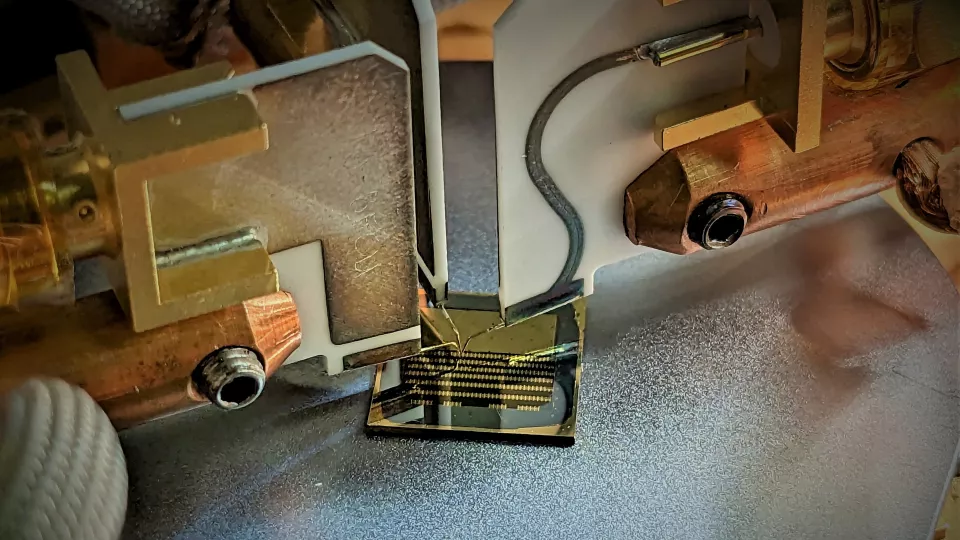Transistors with variable properties are critical components in the development of tomorrow’s semiconductors. As standard transistors approach their size limit, having the most functions on the same number of units has become ever more important to enable the development of small, energy-efficient circuits for improved memory and more powerful computers.

The millimeter-sized chip on which the transistors are located. Image Credit: Anton Persson
Lund University in Sweden researchers demonstrated how to develop new configurable transistors and exert control on a new, more accurate level.
There is a lot of interest in reconfigurable transistors because of the constant need for improved, more potent, and effective circuits. The advantage of these is that, unlike standard semiconductors, they can have their properties changed after they are manufactured.
Scaling down the size of silicon transistors has historically enhanced computer computational power and efficiency (also known as Moore’s Law). But now, a point is reached where the costs of continuing development along those lines have skyrocketed, and quantum mechanics issues have slowed progress.
Rather, new materials, components, and circuits are being sought. Lund University is a world leader in III-V materials, which are silicon substitutes. These are materials with significant potential for use in the development of high-frequency technology (for example, parts for future 6G and 7G networks), optical applications, and progressively energy-efficient electronic components.
To recognize this potential, ferroelectric materials are used. When subjected to an electric field, these special materials can change their inner polarization. It is similar to a regular magnet, but instead of a magnetic north and south pole, electric poles with a positive and negative charge on each side of the material are formed.
It is possible to control the transistor by changing the polarization. Another benefit is that the material “remembers” its polarization even when the current is turned off.
The investigators used a new material combination to construct ferroelectric “grains” that control a tunnel junction—an electrical bridging effect—in the transistor. A grain is 10 nm in size, so this is on an extremely small scale. It has been possible to identify when polarization changes in individual grains and thus fully comprehend how this affects the transistor’s behavior by assessing fluctuations in voltage or current.
The newly published study looked at new ferroelectric memory in the form of transistors with tunnel barriers to create new circuit architectures.
“The aim is to create neuromorphic circuits, i.e., circuits that are adapted for artificial intelligence in that their structure is similar to the human brain with its synapses and neurons,” states Anton Eriksson, who recently completed his doctoral degree in nanoelectronics.
What distinguishes the new findings is the ability to create tunnel junctions using ferroelectric grains located directly adjacent to the junction. These nanograins can then be controlled on an individual level, whereas initially, only entire groups of grains, identified as ensembles, could be tracked. Separate parts of the material can thus be identified and controlled in this manner.
In order to create advanced applications, you must first understand the dynamics in individual grains down to the atomic level, as well as the defects that exist. The increased understanding of the material can be used to optimize the functions. By controlling these ferroelectric grains, you can then create new semiconductors in which you can alter properties. By changing the voltage, you can thus produce different functions in one and the same component.
Lars-Erik Wernersson, Professor, Nanoelectronics, Lund University
The researchers also investigated how this understanding can be used to create various reconfigurable applications by altering the signal that passes through the transistor in various ways. It could be used to create new memory cells or more energy-efficient transistors, for instance.
This new transistor is known as a ferro-TFET, and it can be used in both digital and analog circuits.
“What’s interesting is that it’s possible to modulate the input signal in various ways, for example by the transistor shifting phase, frequency doubling, and signal mixing. As the transistor remembers its properties, even when the current is turned off, there is no need to reset it every time the circuit is used,” adds Zhongyunshen Zho, Doctoral Student in Nanoelectronics.
Another advantage of these transistors is their ability to operate at low voltage. This makes them energy-efficient, which will be necessary for future wireless communication, the Internet of Things, and quantum computers.
I consider this to be leading-edge research of international standing. It’s good that in Lund and Sweden we are at the forefront regarding semiconductors, especially in view of the EU’s recently enacted Chips Act, which aims to strengthen Europe’s position regarding semiconductors.
Lars-Erik Wernersson, Professor, Nanoelectronics, Lund University
Journal References
Zhu, Z., et al. (2023). Reconfigurable signal modulation in a ferroelectric tunnel field-effect transistor. Nature Communications. doi.org/10.1038/s41467-023-38242-w.
Zhu, Z., et al. (2023). Sensing single domains and individual defects in scaled ferroelectrics. Science Advances. doi.org/10.1126/sciadv.ade7098.